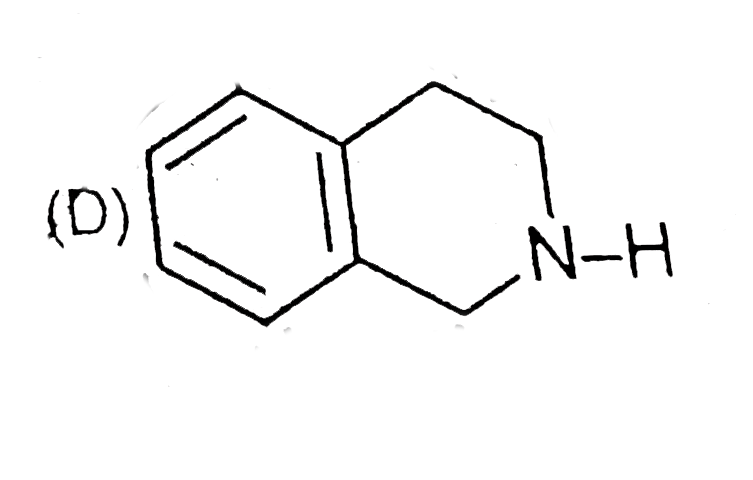Which one of following compound undergoes bromination of its aromatic ring (electrophilic aromatic substitution) at the faster rate ?




To determine which compound undergoes bromination of its aromatic ring (electrophilic aromatic substitution) at a faster rate, we need to analyze the substituents on the aromatic rings provided in the options. The key factor in electrophilic aromatic substitution is the electron density of the aromatic ring, which is influenced by the nature of the substituents attached to it.
1. Understand Electrophilic Aromatic Substitution (EAS):
- EAS involves the substitution of a hydrogen atom on an aromatic ring with an electrophile. The rate of this reaction depends on the electron density of the aromatic ring.
- Electron-rich rings react faster with electrophiles, while electron-poor rings react slower.
2. Identify the Effects of Substituents:
- Substituents can either donate electron density to the ring (activating groups) or withdraw electron density (deactivating groups).
- Activating groups (e.g., -OH, -NH2) increase the electron density and enhance the rate of EAS.
- Deactivating groups (e.g., -NO2, -CF3) decrease the electron density and slow down the reaction.
3. Analyze the Given Options:
- Option 1: Contains a substituent that exhibits only a +I effect (inductive effect), which does not significantly increase electron density.
- Option 2: Contains an -NHR group, where nitrogen has a lone pair that can donate electron density to the ring, exhibiting both +M (mesomeric effect) and +R (resonance effect). This makes the ring electron-rich and enhances the rate of bromination.
- Option 3: Similar to option 1, it exhibits only a +I effect, which is not sufficient for fast bromination.
- Option 4: Contains a substituent that exhibits a -M or -R effect, which withdraws electron density and deactivates the ring towards electrophilic substitution.
4. Conclude the Fastest Bromination Rate:
- Based on the analysis, option 2, which has the -NHR group, is the most electron-rich due to its ability to donate electron density through resonance and inductive effects. Therefore, it will undergo bromination at the fastest rate.
Final Answer:
The compound that undergoes bromination of its aromatic ring at the faster rate is Option 2 (the one with the -NHR group).
- EAS involves the substitution of a hydrogen atom on an aromatic ring with an electrophile. The rate of this reaction depends on the electron density of the aromatic ring.
- Electron-rich rings react faster with electrophiles, while electron-poor rings react slower.
- Substituents can either donate electron density to the ring (activating groups) or withdraw electron density (deactivating groups).
- Activating groups (e.g., -OH, -NH2) increase the electron density and enhance the rate of EAS.
- Deactivating groups (e.g., -NO2, -CF3) decrease the electron density and slow down the reaction.
- Option 1: Contains a substituent that exhibits only a +I effect (inductive effect), which does not significantly increase electron density.
- Option 2: Contains an -NHR group, where nitrogen has a lone pair that can donate electron density to the ring, exhibiting both +M (mesomeric effect) and +R (resonance effect). This makes the ring electron-rich and enhances the rate of bromination.
- Option 3: Similar to option 1, it exhibits only a +I effect, which is not sufficient for fast bromination.
- Option 4: Contains a substituent that exhibits a -M or -R effect, which withdraws electron density and deactivates the ring towards electrophilic substitution.
- Based on the analysis, option 2, which has the -NHR group, is the most electron-rich due to its ability to donate electron density through resonance and inductive effects. Therefore, it will undergo bromination at the fastest rate.
The compound that undergoes bromination of its aromatic ring at the faster rate is Option 2 (the one with the -NHR group).
Similar Questions
Knowledge Check
Which one of the following compounds undergoes bromination of its aromatic ring (electrophilic aromatic substitution) at the fastest rate ?
A B
B C
C D
D
Which of the following compound undergoes bromination on aromatic ring at fastest rate.
A B
B C
C D
D
Which one of the following compounds is not aromatic?
A B
B C
C D
D
Which of the following compound is not aromatic?

View SolutionThe rate determining step in electrophilic aromatic substitution is the
View SolutionWhich of the following compounds is not aromatic ?
View SolutionThe electrophilic aromatic substitution proceeds through a :
View SolutionWhich of the following compounds are aromatic ?
View Solution

